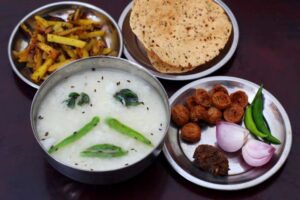WHAT IS FOOD CHAIN ?
A food chain is a linear representation of the feeding relationships within an ecosystem, illustrating how energy and nutrients are transferred from one organism to another through a series of interconnected organisms. In a organisms are categorized into different trophic levels based on their position in the chain.
Here’s a simplified example of a chain:
- Producers: These are the organisms at the base of the chain, such as plants or algae. They are autotrophic, meaning they can produce their own food through photosynthesis by converting sunlight, water, and carbon dioxide into organic matter (glucose).
- Primary Consumers (Herbivores): These are the organisms that consume plants or algae. They are called herbivores because they primarily eat autotrophic producers. Examples include rabbits, deer, and grasshoppers.
- Secondary Consumers (Carnivores): These organisms eat herbivores. They are carnivores because their primary diet consists of other animals. Examples include foxes, snakes, and hawks.
- Tertiary Consumers (Top Predators): These are organisms that feed on other carnivores. They are at the top of the food chain and have few or no natural predators. Examples include apex predators like eagles, lions, and killer whales.
In reality, food often more complex than this simple linear representation. They frequently branch out into interconnected food webs, where multiple species interact and form a more intricate network of feeding relationships. In ecosystems, various organisms can have multiple food sources, and some may occupy different trophic levels depending on their diet at a particular stage of their life cycle.
Food chains and food webs are essential concepts in ecology as they help us understand how energy and nutrients flow through ecosystems, impacting the population dynamics and stability of different species within those ecosystems. Changes in one part of a chain or web can have ripple effects throughout the entire ecosystem, making them crucial for studying and conserving natural environments.
Food chains and explore some important aspects and examples:
1. Trophic Levels:
In a food chain, organisms are categorized into different trophic levels based on their feeding position:
- Producers: These are autotrophic organisms, primarily plants, algae, or some bacteria, capable of converting sunlight into chemical energy through photosynthesis. They form the base of most food chains.
- Primary Consumers (Herbivores): These organisms feed directly on producers. They are called herbivores because their diet consists mainly of plant material.
- Secondary Consumers (Carnivores): These organisms feed on herbivores, making them carnivores. Some secondary consumers can be further divided into:
- Omnivores: They consume both plants and animals.
- Specialized Carnivores: Those that primarily prey on other animals.
- Tertiary Consumers and Beyond: These are top-level predators that may feed on other carnivores or omnivores. They are often the apex predators in a given ecosystem.

2. Energy Transfer:
As energy flows through a food chain, it undergoes a decrease with each trophic level. This decrease is due to energy loss at each level through processes like respiration, digestion, and heat production. As a result, there is typically less energy available at higher trophic levels, which limits the number of individuals that can be supported.
3. Food Webs:
In real ecosystems, food chains are interconnected to form complex food webs. A food web represents the multiple feeding relationships within an ecosystem, accounting for the fact that many organisms have multiple food sources. For example, a predator may consume different prey species, and prey species may have multiple predators.
4. Keystone Species:
Some species in an ecosystem play a disproportionately important role in maintaining the structure and function of the food web. These are called keystone species. Removing a keystone species can have cascading effects throughout the entire ecosystem, potentially leading to its collapse.
5. Examples of Food Chains:
Here are a few examples of food chains in various ecosystems:
- Terrestrial Food Chain: Grass (Producer) -> Rabbit (Primary Consumer) -> Fox (Secondary Consumer) -> Hawk (Tertiary Consumer)
- Aquatic Food Chain: Algae (Producer) -> Zooplankton (Primary Consumer) -> Small Fish (Secondary Consumer) -> Large Fish (Tertiary Consumer)
- Forest Food Chain: Trees (Producer) -> Caterpillar (Primary Consumer) -> Blue Jay (Secondary Consumer) -> Hawk (Tertiary Consumer)
6. Human Impact:
Human activities can disrupt food chains and food webs through habitat destruction, pollution, overfishing, and introduction of invasive species. These disruptions can lead to imbalances in ecosystems and harm biodiversity.
Understanding food chains and food webs is essential for ecological conservation and management. It helps scientists and policymakers make informed decisions to protect and sustain ecosystems for future generations.

7. Ecological Importance:
- Energy Flow: Food chains and food webs illustrate how energy is transferred and flows through ecosystems. This energy fuels all life processes, from growth and reproduction to the functioning of ecosystems.
- Stability: A balanced food web contributes to the stability of an ecosystem. When one species becomes overly abundant or declines, it can disrupt the entire web. For example, the overpopulation of herbivores can lead to overgrazing and a decrease in plant populations.
- Biodiversity: Healthy food webs support biodiversity. Each species in an ecosystem has a unique role, or niche, in the food web. Biodiversity ensures that if one species declines or disappears, others can potentially fill its ecological role.
- Indicators of Environmental Health: Changes in food chains and food webs can serve as indicators of environmental health and disturbances. Monitoring these changes can help scientists identify issues like pollution, habitat loss, or climate change impacts.
8. Energy Pyramids:
- Energy pyramids are graphical representations that show the decreasing energy available at each trophic level in a food chain or web. They are typically shaped like a pyramid, with the base representing the producers and the apex representing the top-level predators.
- Only about 10% of the energy from one trophic level is transferred to the next. The rest is lost as heat or used for the organism’s life processes. This is known as the 10% rule.

9. Detrital Food Chains:
- In addition to the main involving producers and consumers, there are detrital food chains. These involve decomposers like bacteria and fungi that break down dead organic matter (detritus) and recycle nutrients back into the ecosystem.
- Detrital food chains play a critical role in nutrient cycling and are essential for maintaining ecosystem health.
10. Marine Food Chains:
- Marine ecosystems have complex food webs due to the high diversity of species and the interconnectedness of various organisms.
- An example of a marine food chain might include phytoplankton (producers) being consumed by zooplankton (primary consumers), which are then eaten by small fish (secondary consumers), and so on. At the top of the marine food web, you might find apex predators like sharks or dolphins.
11. Arctic Food Chains:
- Arctic ecosystems have unique chains due to the extreme cold and limited plant growth. In these chains, the primary producers are often algae and phytoplankton, while primary consumers can include zooplankton, krill, and small fish. Apex predators in the Arctic include seals, polar bears, and killer whales.
12. Human Impact on Food Webs:
- Human activities, such as overfishing, deforestation, pollution, and habitat destruction, can disrupt food chains and webs. For example, overfishing can deplete top predators, leading to an increase in the populations of their prey species.
- Invasive species introduced by humans can also disrupt native food webs by outcompeting or preying on native species.

13. Conservation and Restoration:
- Understanding food webs is crucial for conservation efforts. Efforts to protect and restore ecosystems often focus on preserving key species and their roles in these networks.
- Restoration projects may involve reintroducing species to restore natural balances or protecting critical habitats.
